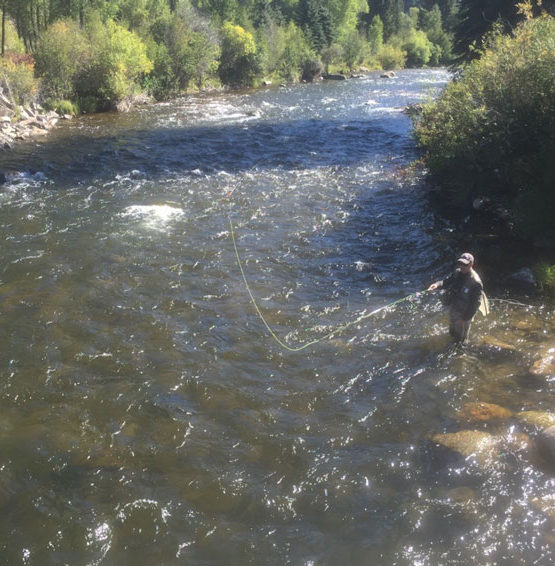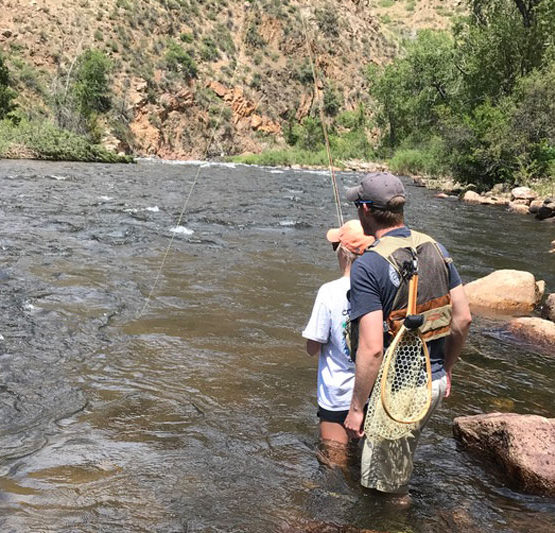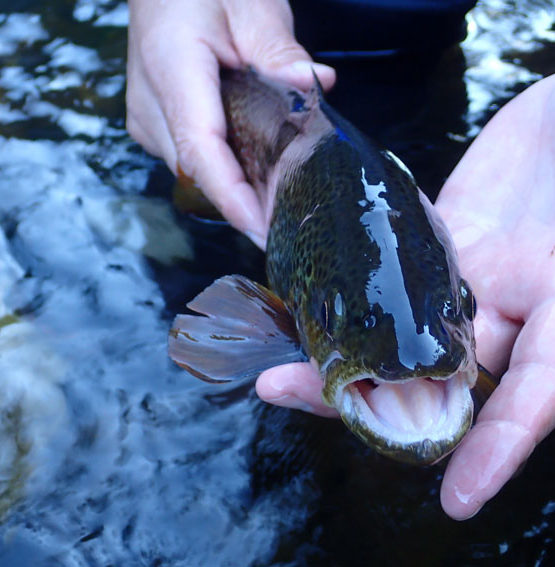Of all the gear choices you have to make when you first get into fly fishing, picking the right fly rod weight can be the most confusing. With so many different options, designed for all sorts of different fly fishing situations, it’s perfectly normal for you to get a little overwhelmed. So, in an effort to provide you with a bit of clarity, allow me to answer the question: what is the best all-around fly rod weight?
In short, 5-weight fly rods are widely considered to be the best all-around choice for anglers; and for good reason. From making delicate casts on small mountain streams, to fighting 20-inch trout on larger rivers and lakes, 5-weight fly rods are versatile enough to handle a wide range of fly fishing scenarios.
That said, while the 5-weight is a good all-around choice for most anglers, it might not be the optimal choice for you.
So how can you figure out which fly rod weight is best for your specific situation and fly fishing desires?
Well, that’s exactly what I am going to answer in the rest of this article.
Let’s get to it!
Disclaimer: This post may contain affiliate links, meaning we will receive a small commission (at no cost to you) if you click through and make a purchase.Understanding Fly Rod Weights
If you’re just getting into fly fishing, and you hear somebody talk about the weight of a fly rod, it’s reasonable to assume that they are either talking about how much the rod weighs, or what amount of weight the rod can withstand while fighting a fish. However, both of those assumptions are wrong.
In fact, the weight of a fly rod is actually just a reference to what size fishing line you can use for the rod.
In other words, when you have a 5-weight fly rod, it just means that the rod is meant to be used with 5-weight line.
But, here’s the thing, with every fly rod, you can increase or decrease your fly line by a step in either direction. So, with a 5-weight rod, you can use a 4-weight, 5-weight, or 6-weight line. And with those three line weights, you have the ability to fish anything from small mountain streams, to bigger rivers with hard-fighting trout. And that’s one of the main reasons why a 5-weight is such a good all-around choice.
Related Posts:
- Buying A Fly Rod: 5 Key Considerations
- What Is A Large-Arbor Fly Reel? Plus 7 Key Advantages
- 7 Best Strike Indicators For Fly Fishing
- 25 Proven Tips To Catch More Trout
- 21 Common Fly Fishing Mistakes To Avoid
- How Often Should You Clean Your Fly Line?
Choosing The Best All-Around Fly Rod Weight For You
As I’ve already mentioned in this article, a 5-weight fly rod is a great all-around choice for most anglers. However, before you just take my word for it and slap down a few hundred dollars on a new fly rod, there are a few things you should consider.
With that in mind, in this next section, I am going to cover three of the main considerations you should take into account when selecting a fly rod weight.
Size And Species Of Fish
In order to pick the best all-around fly rod weight for your situation, the first thing you need to assess is the size and species of fish to which you will be casting.
For example, if you do most of you fishing on small mountain streams and creeks, then a 5-weight might actually be a little heavy for you. I mean, if you’re going to spend your day fighting 10-inch brook trout, then you’re better off buying a 4-weight, or even a 3-weight fly rod. The lighter weight will help you finesse the fish a little more, and make the whole experience more enjoyable.
On the other hand, if you plan to use your new fly rod for larger rivers — where you’ll be making long casts and fighting big fish — then a 6-weight might be a better choice for you. Additionally, if you plan to do any salmon, or saltwater fishing, then a 5-weight is probably way too light of a rod. As a general rule of thumb, a 5-weight is a great rod for fish between 10” and 20” long. Anywhere outside that range, and you should start considering a different weight.
Wind Conditions
If there’s one thing I can’t stand when I’m fly fishing, it’s windy conditions. There’s nothing like 30-40 mile-per-hour gusts to wreck a day on the water. And here’s the thing, if you do most of your fishing in windy locations, then a 5-weight might not have enough juice to cast through it.
So, if you consistently encounter windy fishing locations — or you plan on casting your new fly rod anywhere in Wyoming — then you should opt for a 6-weight.
Type Of Fly Fishing
When you start looking for a new fly rod, one of the key considerations you should take into account, is the type of fishing for which you will be using your fly rod most of the time. In other words, will you be slinging dry flies, nymphs, or streamers?
If your focus will be on dry flies, then a 5-weight might be a great choice for you. However, if you plan on throwing some nymphs or streamers around — which are significantly heavier — then you might want to opt for a 6-weight.
Recommended Fly Rods
Ok, so now that you’ve had an opportunity to assess your needs and wants from a fly rod, the next, and obvious, question is, what fly rod should you actually buy?
Well, here are the fly rods that we recommend:
- For Small Stream Fishing – We recommend an Orvis Clearwater 8′ 6″ 5wt. Since small streams and small fish don’t typically require long casts in difficult conditions, there’s no real need to break the bank on a fly rod. For the money, this rod will more than do the trick. Plus, the slightly shorter length can help for tight casting situations.
- For Mid-Size Streams And Fish Up To 18″ – We recommend an Orvis Recon 9′ 5wt. Put simply, I love this fly rod! I have been fishing with the predecessor to the Recon for over a decade, and to this day, it casts like a brand new rod. This rod will cost you around $500, but it is worth every penny. Of all the fly rods we recommend, this is probably the most versatile.
- For Large Fish, Big Streams, And Windy Conditions – We recommend an Orvis Helios 9′ 6wt. This fly rod has the strength to power a dry fly through strong winds, accuracy to comb the banks with an articulated streamer, yet enough delicacy to land a size 18 Trico on the snout of a leader-shy trout. This is one of the more expensive fly rods we recommend, but you’ll be glad you spent the money when you slam the take on a 30″ brown. We’ve all been there, right?
Bottom Line
In order to determine the best all-around fly rod weight for your situation, there are a few things you should assess. Between the size and species of the fish you will be trying to catch, the casting conditions, and the types of flies with which you’ll be fishing, you have a few things to consider.
Though, after all is said and done, if you still can’t decide on a fly rod, then it’s hard to go wrong with the trusty ol’ 9-foot 5-weight.
Ok, so I’m going to assume that if you read through this entire article, you either found it helpful or enjoyable. And if that’s the case, then you should subscribe to our email list. If I’m being honest, it’s like the third-best fly fishing email list out there. But, since you don’t know about the first two, I’m just going to take the win and drop the mic. (Victory is sweet!)
Related Posts:











I first started fly-fishing in the early 1980s, using old bamboo fly rods I borrowed from my uncle for pan fishing…. I assume bought a modern fly rod and reel for myself, enjoy that for several years but then work in life and family took precedence overfishing…. now I always like to get back into fly fishing and buy a new updated equipment, panfish and then have a second rig for bass both Smallmouth and Largemouth…. thank you for all your information in articles I’m thinking about having a number 4 for panfish and smaller rivers or streams and the number 7 rigged for bass and strong Smalley’s…… I live in northern Indiana we do have trout and salmon that come out of Lake Michigan and spawn up in st.joe River but I would probably use spinning tackle for the such a species…. I guess someday it would be awesome to catch a chinook salmon on a fly rod though…. thanks again for the information, Steve
For new anglers, get a medium-action fly rod. They are the most versatile of fly rods and are pretty forgiving to learn on. If you want to know more about fly rod action, read the How to Select a Fly Rod Guide .